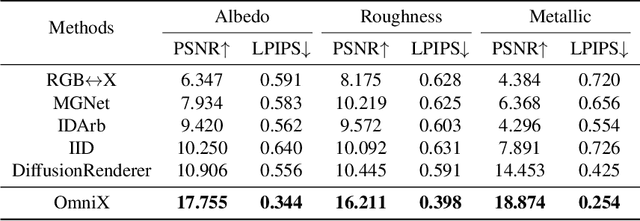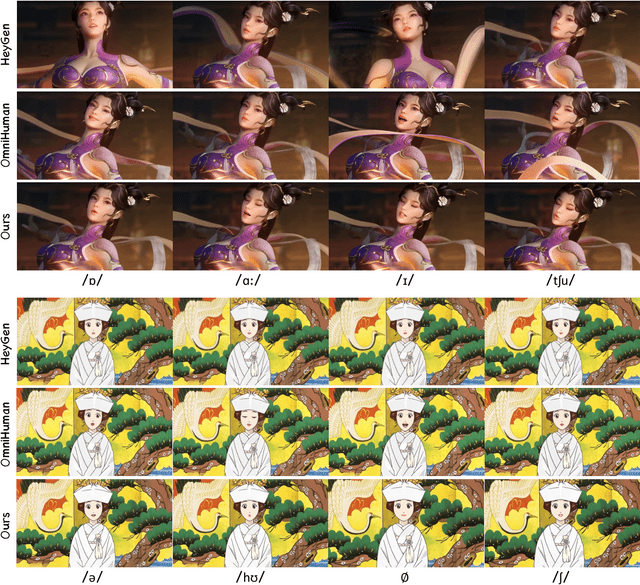Pengfei Wan
OmniX: From Unified Panoramic Generation and Perception to Graphics-Ready 3D Scenes
Oct 30, 2025



Abstract:There are two prevalent ways to constructing 3D scenes: procedural generation and 2D lifting. Among them, panorama-based 2D lifting has emerged as a promising technique, leveraging powerful 2D generative priors to produce immersive, realistic, and diverse 3D environments. In this work, we advance this technique to generate graphics-ready 3D scenes suitable for physically based rendering (PBR), relighting, and simulation. Our key insight is to repurpose 2D generative models for panoramic perception of geometry, textures, and PBR materials. Unlike existing 2D lifting approaches that emphasize appearance generation and ignore the perception of intrinsic properties, we present OmniX, a versatile and unified framework. Based on a lightweight and efficient cross-modal adapter structure, OmniX reuses 2D generative priors for a broad range of panoramic vision tasks, including panoramic perception, generation, and completion. Furthermore, we construct a large-scale synthetic panorama dataset containing high-quality multimodal panoramas from diverse indoor and outdoor scenes. Extensive experiments demonstrate the effectiveness of our model in panoramic visual perception and graphics-ready 3D scene generation, opening new possibilities for immersive and physically realistic virtual world generation.
VFXMaster: Unlocking Dynamic Visual Effect Generation via In-Context Learning
Oct 29, 2025Abstract:Visual effects (VFX) are crucial to the expressive power of digital media, yet their creation remains a major challenge for generative AI. Prevailing methods often rely on the one-LoRA-per-effect paradigm, which is resource-intensive and fundamentally incapable of generalizing to unseen effects, thus limiting scalability and creation. To address this challenge, we introduce VFXMaster, the first unified, reference-based framework for VFX video generation. It recasts effect generation as an in-context learning task, enabling it to reproduce diverse dynamic effects from a reference video onto target content. In addition, it demonstrates remarkable generalization to unseen effect categories. Specifically, we design an in-context conditioning strategy that prompts the model with a reference example. An in-context attention mask is designed to precisely decouple and inject the essential effect attributes, allowing a single unified model to master the effect imitation without information leakage. In addition, we propose an efficient one-shot effect adaptation mechanism to boost generalization capability on tough unseen effects from a single user-provided video rapidly. Extensive experiments demonstrate that our method effectively imitates various categories of effect information and exhibits outstanding generalization to out-of-domain effects. To foster future research, we will release our code, models, and a comprehensive dataset to the community.
GRPO-Guard: Mitigating Implicit Over-Optimization in Flow Matching via Regulated Clipping
Oct 25, 2025Abstract:Recently, GRPO-based reinforcement learning has shown remarkable progress in optimizing flow-matching models, effectively improving their alignment with task-specific rewards. Within these frameworks, the policy update relies on importance-ratio clipping to constrain overconfident positive and negative gradients. However, in practice, we observe a systematic shift in the importance-ratio distribution-its mean falls below 1 and its variance differs substantially across timesteps. This left-shifted and inconsistent distribution prevents positive-advantage samples from entering the clipped region, causing the mechanism to fail in constraining overconfident positive updates. As a result, the policy model inevitably enters an implicit over-optimization stage-while the proxy reward continues to increase, essential metrics such as image quality and text-prompt alignment deteriorate sharply, ultimately making the learned policy impractical for real-world use. To address this issue, we introduce GRPO-Guard, a simple yet effective enhancement to existing GRPO frameworks. Our method incorporates ratio normalization, which restores a balanced and step-consistent importance ratio, ensuring that PPO clipping properly constrains harmful updates across denoising timesteps. In addition, a gradient reweighting strategy equalizes policy gradients over noise conditions, preventing excessive updates from particular timestep regions. Together, these designs act as a regulated clipping mechanism, stabilizing optimization and substantially mitigating implicit over-optimization without relying on heavy KL regularization. Extensive experiments on multiple diffusion backbones (e.g., SD3.5M, Flux.1-dev) and diverse proxy tasks demonstrate that GRPO-Guard significantly reduces over-optimization while maintaining or even improving generation quality.
Terra: Explorable Native 3D World Model with Point Latents
Oct 16, 2025Abstract:World models have garnered increasing attention for comprehensive modeling of the real world. However, most existing methods still rely on pixel-aligned representations as the basis for world evolution, neglecting the inherent 3D nature of the physical world. This could undermine the 3D consistency and diminish the modeling efficiency of world models. In this paper, we present Terra, a native 3D world model that represents and generates explorable environments in an intrinsic 3D latent space. Specifically, we propose a novel point-to-Gaussian variational autoencoder (P2G-VAE) that encodes 3D inputs into a latent point representation, which is subsequently decoded as 3D Gaussian primitives to jointly model geometry and appearance. We then introduce a sparse point flow matching network (SPFlow) for generating the latent point representation, which simultaneously denoises the positions and features of the point latents. Our Terra enables exact multi-view consistency with native 3D representation and architecture, and supports flexible rendering from any viewpoint with only a single generation process. Furthermore, Terra achieves explorable world modeling through progressive generation in the point latent space. We conduct extensive experiments on the challenging indoor scenes from ScanNet v2. Terra achieves state-of-the-art performance in both reconstruction and generation with high 3D consistency.
Mitigating the Noise Shift for Denoising Generative Models via Noise Awareness Guidance
Oct 14, 2025Abstract:Existing denoising generative models rely on solving discretized reverse-time SDEs or ODEs. In this paper, we identify a long-overlooked yet pervasive issue in this family of models: a misalignment between the pre-defined noise level and the actual noise level encoded in intermediate states during sampling. We refer to this misalignment as noise shift. Through empirical analysis, we demonstrate that noise shift is widespread in modern diffusion models and exhibits a systematic bias, leading to sub-optimal generation due to both out-of-distribution generalization and inaccurate denoising updates. To address this problem, we propose Noise Awareness Guidance (NAG), a simple yet effective correction method that explicitly steers sampling trajectories to remain consistent with the pre-defined noise schedule. We further introduce a classifier-free variant of NAG, which jointly trains a noise-conditional and a noise-unconditional model via noise-condition dropout, thereby eliminating the need for external classifiers. Extensive experiments, including ImageNet generation and various supervised fine-tuning tasks, show that NAG consistently mitigates noise shift and substantially improves the generation quality of mainstream diffusion models.
Kling-Avatar: Grounding Multimodal Instructions for Cascaded Long-Duration Avatar Animation Synthesis
Sep 11, 2025



Abstract:Recent advances in audio-driven avatar video generation have significantly enhanced audio-visual realism. However, existing methods treat instruction conditioning merely as low-level tracking driven by acoustic or visual cues, without modeling the communicative purpose conveyed by the instructions. This limitation compromises their narrative coherence and character expressiveness. To bridge this gap, we introduce Kling-Avatar, a novel cascaded framework that unifies multimodal instruction understanding with photorealistic portrait generation. Our approach adopts a two-stage pipeline. In the first stage, we design a multimodal large language model (MLLM) director that produces a blueprint video conditioned on diverse instruction signals, thereby governing high-level semantics such as character motion and emotions. In the second stage, guided by blueprint keyframes, we generate multiple sub-clips in parallel using a first-last frame strategy. This global-to-local framework preserves fine-grained details while faithfully encoding the high-level intent behind multimodal instructions. Our parallel architecture also enables fast and stable generation of long-duration videos, making it suitable for real-world applications such as digital human livestreaming and vlogging. To comprehensively evaluate our method, we construct a benchmark of 375 curated samples covering diverse instructions and challenging scenarios. Extensive experiments demonstrate that Kling-Avatar is capable of generating vivid, fluent, long-duration videos at up to 1080p and 48 fps, achieving superior performance in lip synchronization accuracy, emotion and dynamic expressiveness, instruction controllability, identity preservation, and cross-domain generalization. These results establish Kling-Avatar as a new benchmark for semantically grounded, high-fidelity audio-driven avatar synthesis.
Easier Painting Than Thinking: Can Text-to-Image Models Set the Stage, but Not Direct the Play?
Sep 03, 2025Abstract:Text-to-image (T2I) generation aims to synthesize images from textual prompts, which jointly specify what must be shown and imply what can be inferred, thereby corresponding to two core capabilities: composition and reasoning. However, with the emerging advances of T2I models in reasoning beyond composition, existing benchmarks reveal clear limitations in providing comprehensive evaluations across and within these capabilities. Meanwhile, these advances also enable models to handle more complex prompts, whereas current benchmarks remain limited to low scene density and simplified one-to-one reasoning. To address these limitations, we propose T2I-CoReBench, a comprehensive and complex benchmark that evaluates both composition and reasoning capabilities of T2I models. To ensure comprehensiveness, we structure composition around scene graph elements (instance, attribute, and relation) and reasoning around the philosophical framework of inference (deductive, inductive, and abductive), formulating a 12-dimensional evaluation taxonomy. To increase complexity, driven by the inherent complexities of real-world scenarios, we curate each prompt with high compositional density for composition and multi-step inference for reasoning. We also pair each prompt with a checklist that specifies individual yes/no questions to assess each intended element independently to facilitate fine-grained and reliable evaluation. In statistics, our benchmark comprises 1,080 challenging prompts and around 13,500 checklist questions. Experiments across 27 current T2I models reveal that their composition capability still remains limited in complex high-density scenarios, while the reasoning capability lags even further behind as a critical bottleneck, with all models struggling to infer implicit elements from prompts. Our project page: https://t2i-corebench.github.io/.
MIDAS: Multimodal Interactive Digital-humAn Synthesis via Real-time Autoregressive Video Generation
Aug 28, 2025Abstract:Recently, interactive digital human video generation has attracted widespread attention and achieved remarkable progress. However, building such a practical system that can interact with diverse input signals in real time remains challenging to existing methods, which often struggle with heavy computational cost and limited controllability. In this work, we introduce an autoregressive video generation framework that enables interactive multimodal control and low-latency extrapolation in a streaming manner. With minimal modifications to a standard large language model (LLM), our framework accepts multimodal condition encodings including audio, pose, and text, and outputs spatially and semantically coherent representations to guide the denoising process of a diffusion head. To support this, we construct a large-scale dialogue dataset of approximately 20,000 hours from multiple sources, providing rich conversational scenarios for training. We further introduce a deep compression autoencoder with up to 64$\times$ reduction ratio, which effectively alleviates the long-horizon inference burden of the autoregressive model. Extensive experiments on duplex conversation, multilingual human synthesis, and interactive world model highlight the advantages of our approach in low latency, high efficiency, and fine-grained multimodal controllability.
Score Augmentation for Diffusion Models
Aug 11, 2025Abstract:Diffusion models have achieved remarkable success in generative modeling. However, this study confirms the existence of overfitting in diffusion model training, particularly in data-limited regimes. To address this challenge, we propose Score Augmentation (ScoreAug), a novel data augmentation framework specifically designed for diffusion models. Unlike conventional augmentation approaches that operate on clean data, ScoreAug applies transformations to noisy data, aligning with the inherent denoising mechanism of diffusion. Crucially, ScoreAug further requires the denoiser to predict the augmentation of the original target. This design establishes an equivariant learning objective, enabling the denoiser to learn scores across varied denoising spaces, thereby realizing what we term score augmentation. We also theoretically analyze the relationship between scores in different spaces under general transformations. In experiments, we extensively validate ScoreAug on multiple benchmarks including CIFAR-10, FFHQ, AFHQv2, and ImageNet, with results demonstrating significant performance improvements over baselines. Notably, ScoreAug effectively mitigates overfitting across diverse scenarios, such as varying data scales and model capacities, while exhibiting stable convergence properties. Another advantage of ScoreAug over standard data augmentation lies in its ability to circumvent data leakage issues under certain conditions. Furthermore, we show that ScoreAug can be synergistically combined with traditional data augmentation techniques to achieve additional performance gains.
DiffCap: Diffusion-based Real-time Human Motion Capture using Sparse IMUs and a Monocular Camera
Aug 08, 2025Abstract:Combining sparse IMUs and a monocular camera is a new promising setting to perform real-time human motion capture. This paper proposes a diffusion-based solution to learn human motion priors and fuse the two modalities of signals together seamlessly in a unified framework. By delicately considering the characteristics of the two signals, the sequential visual information is considered as a whole and transformed into a condition embedding, while the inertial measurement is concatenated with the noisy body pose frame by frame to construct a sequential input for the diffusion model. Firstly, we observe that the visual information may be unavailable in some frames due to occlusions or subjects moving out of the camera view. Thus incorporating the sequential visual features as a whole to get a single feature embedding is robust to the occasional degenerations of visual information in those frames. On the other hand, the IMU measurements are robust to occlusions and always stable when signal transmission has no problem. So incorporating them frame-wisely could better explore the temporal information for the system. Experiments have demonstrated the effectiveness of the system design and its state-of-the-art performance in pose estimation compared with the previous works. Our codes are available for research at https://shaohua-pan.github.io/diffcap-page.
 Add to Chrome
Add to Chrome Add to Firefox
Add to Firefox Add to Edge
Add to Edge